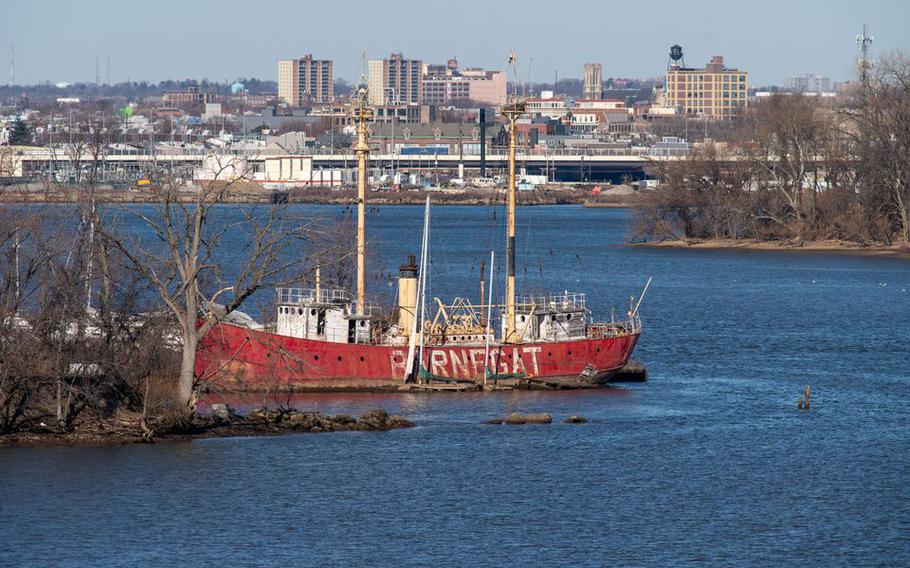
Barnegat Lightship docked on the Delaware River in Camden, Tuesday, Feb. 14, 2023. (Joe Warner, for NJ Advanced Media/TNS)
For more than 60 years, the Barnegat Lightship flashed its familiar signal to ships as they made their way along the New Jersey coast, up to New York Harbor or down to Chesapeake Bay.
From 1904 to 1967, the floating lighthouse weathered every storm and survived every near miss from the ocean liners, cargo ships and fishing boats that often passed too close for comfort. Initially stationed off Cape May, the Barnegat spent most of its seagoing life anchored seven miles off the tip of Long Beach Island, offering safe passage to ships at night with its signature rotating flash:
Eight seconds on. Two seconds off. One blast of the steam whistle every 20 seconds.
During the day, the bright red hull with the white letters that spelled “Barnegat” was all a mariner needed to see to know where he was. But in fog, all bets were off.
“Ships were supposed to stay at least two miles away, but in fog they would come in close,” recalled John Hedgepeth, 84, a Tuckerton resident who was stationed aboard the Barnegat with the U.S. Coast Guard from 1965 to 1967. “So close that I couldn’t see the ship, but I could hear the propeller wash. And that’s too close.”
Hedgepeth was a part of a small crew numbering about seven Coast Guard sailors who manned the Barnegat, standing lookout on the bridge for ships and keeping fire watch down below. Crews alternated every two weeks; storms came and storms went, but the Barnegat stayed.
“If you had sea sickness, you didn’t want to be out there. It rocked all the time; that’s what it was designed to do,” Hedgepeth said. “But I liked it. The food was good and it was pretty loose. We had a good gig.”
Like other lightships, the Barnegat was made obsolete by better technology, mainly the radio-directed LORAN system. The light that had shone through countless Nor’easters, tropical storms and the occasional hurricane was shut off for good in 1967, when the Coast Guard decommissioned the Barnegat.
Since then, it’s been 60 years of mostly darkness and rust for the landmark vessel, which has taken on water but is somehow still afloat at a rundown marina on the Camden waterfront. The Barnegat has been stuck in the mud at the Pyne Poynt Marina since the 1990s, when a community activist, Rodney Sadler, first rescued the vessel from a Philadelphia non-profit that couldn’t afford the upkeep and towed the boat across the Delaware River Camden, where it was built.
Sadlier’s dream was to raise enough money to fix the Barnegat and turn the marina into a park, but the arrival of the Battleship New Jersey in 2001 sunk that idea. Sadler died four years ago with the ship stuck ever deeper in the mud, but a break came in late April when the Camden County Board of Commissioners voted to buy the seven-acre marina for $633.000 from Sadler’s wife, Anna, and turn it into a waterfront park.
The 668-ton Barnegat comes with the property. And although Camden County officials are not sure the lightship can be saved, they are willing to find out.
“I can’t definitely say what’s going to happen,” Camden County Commissioner Jeff Nash told NJ Advance Local following the sale last week. “Somebody is going to have to take a hard look at the Barnegat and see if it’s worth preserving. “I’m hoping we can preserve it.”
The Barnegat was one of 116 lightship stations established by the U.S. government between 1820 and 1983. The Barnegat is one of only 15 that remain, according to the U.S. Coast Guard Lightship Sailors Association International.
The remaining lightships have all been preserved, and now serve as floating museums. One ship, the Frying Pan, was rescued from the muck in Virginia, towed to Chelsea Piers in Manhattan, and is now a restaurant. Also in Manhattan, Lightship Ambrose is one of the attractions at the South Street Seaport.
Closest to the Barnegat in Lewes, Del. sits the Lightship Overalls, which was restored with about $1.2 million in federal, state, and local grants and an estimated 40,000 hours of volunteer labor.
The Barnegat has been tied up at the Pyne Poynt Marina since the mid-1990s, and the few people who have gotten a close-up look recently say the lightship has taken on water and needs major repairs. But at 668 tons, there’s still a lot of ship.
“From what I could tell, everything was intact. She looks to be in remarkably good shape for what she’s been through,” said John Schaeffer, the Cape May lighthouse keeper who last month went looking for the Barnegat with Mark Allen, a reporter from the local newspaper, the Cape May Star and Wave. He took pictures.
“It’s a ship sitting in brackish water. With every passing day, she gets a little older. It’s going to take somebody to create a restoration plan.”
“When I looked at it, water was engine room was completely submerged and water was almost up to the main deck,” said Robert Frymoyer, a retired Camden firefighter who served aboard the Barnegat for 13 months, beginning in 1965. “The portholes had been knocked out, and the deck is in bad shape.”
Frymoyer was part of a small group that wanted to restore the Barnegat. Frymoyer, his wife, and another group member, Jaimie Simpson, met with the Overfalls Foundation last year seeking advice on how to get the project started. But the fundraising effort never got off the ground and the group disbanded, Frymoyer said.
Simpson, a self-described “lighthouse nerd” who works as a nurse in Pennsylvania, said she hasn’t given up hope. “I believe with the right amount of money, anything would be possible,” she said.
©2023 Advance Local Media LLC.
Visit nj.com.
Distributed by Tribune Content Agency, LLC.